
A routine is a beautiful thing—until it’s just the same 5K run, the same 5K race results, the same ride, the same way it checks the workout box. Time to go all-in.
Commit to that thing you keep saying “someday” to. Go epic not just for the bragging rights but because scores of studies back up what you suspected: Big goals lead to bigger efforts and, when you reach them, greater feelings of self-satisfaction.
Plus, you can’t hit a hairy fitness goal without getting in the best shape of your life.
Take On Summits Like Free Solo
Ask Alex Honnold. His 2017 climb up El Capitan without ropes—featured in the recent documentary Free Solo—was basically the ultimate Big Goal (the penalty for one missed toehold is death). “I’d been thinking about free-soloing El Cap for years and waiting for it to happen, but then I realized it was never going to happen unless I put in the work.”
Honnold turned a nebulous desire into an in-focus target—and then got to work. Now it’s your turn.
Go Higher
When there are a couple thousand feet between you and the ground—or any other time you’re aiming big—you’ve got to have muscle strength and a way to manage fear. Alex Honnold, 33, one of the greatest climbers of all time, reveals what it takes to really reach.
Figure Out What You’re Actually Afraid Of
“Most people aren’t afraid of heights; they’re afraid of falling and dying. I’m afraid of falling and dying; that’s totally natural and normal,” Honnold says. If you think you’re afraid of heights, reframe it as being afraid of falling, then determine why you think you might fall.
“If it’s because you don’t trust your equipment, work on that.” If you don’t trust the person belaying you, find a way to build that relationship. But framing your fear as specific—and solvable—makes conquering doubt much more doable.
Aim for Joy, Not Euphoria
When Honnold reached the top of El Cap, he was surprisingly subdued. A significant part of making the attempt was working slowly through the wall’s challenges until it felt easy, so it was no major surprise when he made it. “I liken it to a slot machine: When you have a one-in-a-million chance, you know it’s so unlikely for it to work out, so it feels crazy to win. But if you have a 99 percent chance of winning, it feels good, but not like some crazy, crazy celebration.”
Rock climbing, with or without ropes, is dangerous. Work with the odds in your favor, even if you don’t get that just-shot-the-moon sensation after the fact.
View this post on Instagram
A post shared by Alex Honnold (@alexhonnold) on
Feeling Awful Is Normal
“Someone recently said to me about running: ‘It never feels easier—you just go faster.’ A lot of sports always feel terrible. Climbing is always like that. You always feel weak and like you suck, but you can do harder and harder things.”
Breathe Heavily
Climbing isn’t purely about strength; you have to be aerobically fit, too. In Free Solo, you can hear Honnold’s breath quicken as he works his way up the wall. Frequent climbing is essential, but Honnold says he couldn’t have become fit enough through climbing alone. So he spent hours hiking up and down mountainsides. Choose routes with huge elevation gains to work your heart as well as your quads and glutes.
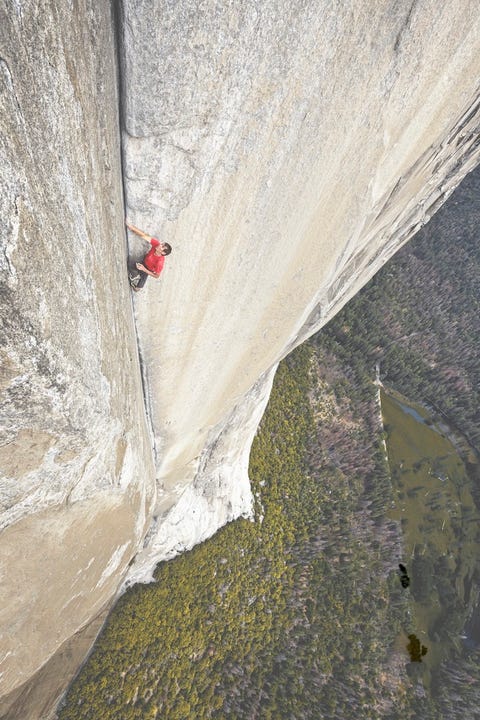
Jimmy Chin
Make High Happen
Honnold’s guide to beginner climbing.
Step 1: Get Help
“When I started, classes weren’t really available. Climbing was still a fringe thing,” says the self-taught athlete. Plus, as a shy kid, he wasn’t good at asking for help. Instead, “I read a lot of books and climbing magazines,” he says. It worked for him, but for most people, a basic intro-to-climbing course makes them comfortable with the sport’s
rules, jargon, and safe habits from the get-go.
Step 2: Focus on Your Feet First
As a beginner climber, you probably won’t have the grip or arm strength to pull yourself up the wall, so concentrating on how and where you place your feet will help you build a solid foundation while you work on developing your pullup prowess.
Step 3: Build Your Grip
Climbing a lot can get you most of the strength you need, says Honnold, but you can accelerate your gains by working your arms off a hangboard. That’s basically a pullup “bar” that’s a totally flat surface, which forces you to use finger and hand strength. Start by just hanging. Slowly extend the time you can hang, then work toward pullups. For a more detailed plan, follow these tips.
Build the Strength to Bike Up a Mountain

Getty ImagesTy Allison
You can’t bike to the top of Everest, but that’s not stopping cyclists from tackling a feat called Everesting: climbing all 29,029 feet via short laps of the same hill. JJ Zhou, 24, upped the game and did those laps on Everest itself last August. His take on what strength is about.
Get Stronger
Do a Molehill First
Zhou Everested on a different mountain before taking on actual Everest. “It was in Nanjing [China], on the Purple Mountain, which is where I learned to ride a bike. It snowed the day before, so I had to go out with my parents and shovel a 1.2-kilometer section. They hated me by the end of that.”
Everest’s grade made that climb much harder, but the fact that he’d already done the challenge elsewhere gave him the confidence he needed to attempt
the tougher goal, he says.
Mind Your Middle
Sure, quads thicker than cordwood won’t hurt your attempt, but what you really need is a core that won’t quit. “When I was building up, I was lean and in tip-top shape, but my core stability wasn’t good. My back would get achy, which was a sign that I’d cashed out my core strength,” he says.
Without a strong middle, you’ll rock back and forth as you climb. (See how he builds his with Zhou’s Seriously Strong Circuit, below.) That extra movement is wasted energy you could be using to go up.
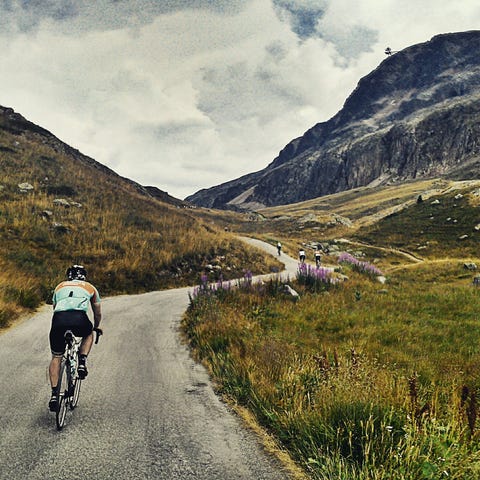
Getty ImagesRichárd Katona / EyeEm
Enlist Reinforcements
“By the time I reached 7,000 meters of elevation, I was completely fucked. Nothing in my body was functioning, and I was like, ‘I need someone to ride with me,’ ” he says.
Zhou had started the day with four other riders, which dropped to three, then two, then one. “It wasn’t so much that they dropped out but realized they weren’t going to make it in the 40 hours we’d allowed,” he says.
When Zhou asked for help, his tired teammates suited back up and took turns helping him finish. Without them, throwing in the towel may have been a more appealing option.
Work Your Gray Matter
For the first ten hours, Zhou says, his physical strength mattered. For the last 30, “everything became about what was between the ears.”
On an attempt like this, you don’t have a change of scenery to distract you—it’s the same stretch of road over and over again. “Meditation has been a very big part of daily life,” he says, adding that he does meditative breath work while exercising, versus doing traditional sit-on-your-butt meditation. “Some people would say, ‘Oh, he’s not serious about meditation,’ but it’s what works for me.”
Zhou’s Seriously Strong Circuit
To build core, leg, and back strength all at once, incorporate Zhou’s three-move circuit into your weekly schedule. He does 50 seconds of each move, with 10 seconds of rest in between. “Repeat as many times as you can stand it,” he says.
Move 1: Plank with Knee to Elbow
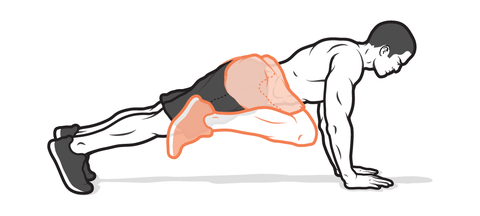
Matius Gerardo Griek
Why: This is great for teaching your core to stay stable as you’re moving.
Do it well: Start in a high-plank position—basically, a pushup position. Lift your right foot off the floor and draw your knee up to your right elbow. Pause for a moment, then return to the start. Repeat on the left side. Alternate for 50 seconds.
Move 2: Hex-Bar Deadlift

Matius Gerardo Griek
Why: This is more effective for your core than a deadlift with a traditional barbell.]
Do it well: Stand in the hex bar, feet shoulder-width apart. Keep your back straight, bend your knees, push your hips back, and pick up the bar by the handles. Keeping your back flat, push up to standing. Brace your core, and slowly return the bar to the ground.
Move 3: Turkish Getup with Kettlebell
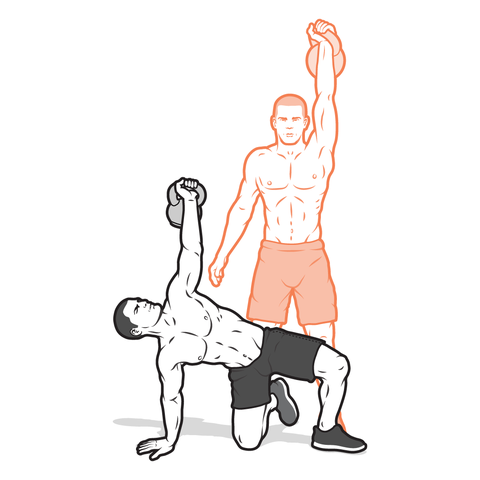
Matius Gerardo Griek
Why: This creates well-rounded functional strength.
Do it well: Start by lying on the ground, kettlebell in your left hand, left knee bent. While still on the ground, press the kettlebell straight above your shoulder. Then keep reaching upward—kettlebell overhead and core strong at all times—until you’re in a standing position. Repeat on the other side.
Run a Marathon Like a World Record-Breaker
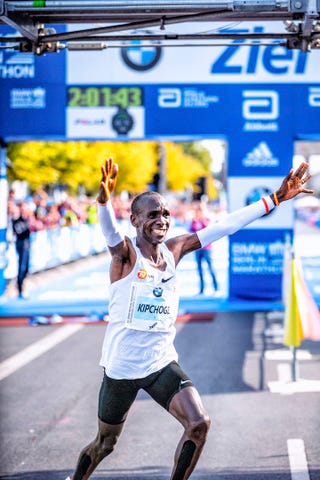
NN Running
Eliud Kipchoge, 34, didn’t “break two” in 2017, when he and Nike tested if it’s possible to run a sub-two-hour marathon. But that didn’t keep him from crushing the world record in Berlin in 2018, clocking 2:01:39. His philosophies could help even mortals hit a PR.
Run Through the Lows
Good news: Even Kipchoge has days when he doesn’t want to run. Bad news: He gets out there anyway. So should you.
“[Eventually,] if I keep on running, the body will respond,” he says. “You can’t let the bad days deter you.” A marathon is like life, he says, with the hard times making the payoff so much more worth it.
Be Meticulous
Kipchoge logs every single one of his workouts in a notebook. It’s like a ledger at a bank, keeping track of everything he’s invested. “When the race is hurting, I start to think of my great workouts and training,” he says.
Reflecting on the amount of cash in the bank, he always knows exactly how much he has to spend. If you do the same, he says, “all will be well—trust me.”
Don’t Be Afraid to Come Up Short
“The best lesson an athlete can learn from failing is that failing is not suicide,” Kipchoge says. Instead, it indicates that you’re pushing your limits.
To him, failure is an integral part of running—and yes, he’s had some not-so-glorious moments of defeat, like not making Kenya’s 2012 Olympic team. “If an athlete misses a goal, never get discouraged. There’s always the next day. Wake up and move on.”
Run Faster at Any Distance

Getty ImagesWestend61
The elite Mammoth Track Club, in Mammoth Lakes, California, has produced greats like Meb Keflezighi and Ryan Hall. Head coach Andrew Kastor says these speedwork sets—done less than once a week—can work for regular runners, too.
Distance: 5K
The workout: 8×400 meters at 1-mile race pace.
Why it works: For this distance, you need to be able to perform right above your anaerobic threshold. That means you should barely be able to say more than a few words at a time. To train that system, you need short, hard efforts, like these 400-meter (that’s 1 lap of the track) repeats.
Do it right: Warm up with 15 minutes of easy running, then take 1 minute of recovery (but no more) between each lap.
Distance: 10K
The workout: 12×400 meters at 5K race pace.
Why it works: A 10K is run right at your anaerobic threshold, meaning a pace you can hold (but that’s moderately uncomfortable) for 45-ish minutes. Running at a 5K pace helps push your aerobic fitness upward; doing more repeats than the 5K runners do builds mental toughness.
Do it right: Warm up for at least 15 minutes. Between laps, rest in a 1-to-1 ratio. So if you do the lap in 90 seconds, you recover for 90 seconds.
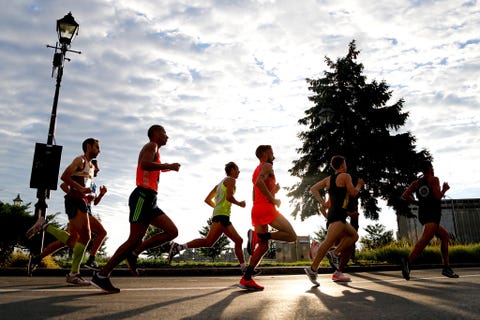
Getty ImagesMichael Reaves
Distance: Half Marathon
The workout: 8×800 meters at under 10K pace.
Why it works: “A half marathon is below anaerobic threshold pace, so it’s more comfortable and manageable but you have to go twice the distance,” Kastor says. So your speedwork needs to be slightly slower but with more overall mileage to increase endurance.
Do it right: After a 15-minute warmup, take 2 or 2 ½ minutes of rest between each interval, but no more. “Otherwise, the heart slows too much.”
Distance: Marathon
The workout: 5×1 mile at 10K pace.
Why it works: “For marathons, I change the 80/20 rule to 90/10,” Kastor says—in other words, your speedwork is a relatively small part of your training.
Do it right: Warm up thoroughly and take no more than 2 ½ minutes of rest between mile repeats. Also: If you just aren’t feeling the speedwork that day, you can abandon it, but you still need to get your miles in. When it comes to a marathon, “volume is what’s important.”
Source: Read Full Article